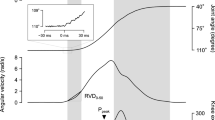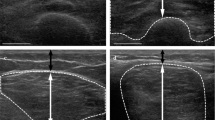Abstract
Muscle quality is an important component of the functional profile of the elderly, and previous studies have shown that both muscle quantity and quality independently contribute to muscle strength of the elderly. This study aimed to verify the association between quadriceps femoris muscle quality, analyzed by specific tension and echo intensity (EI), and rate of torque development (RTD) of the knee extensor muscles with the functional performance in elderly active women. Forty-five healthy, active elderly women (70.28 ± 6.2) volunteered to participate in this study. Quadriceps femoris muscle thickness and EI were determined by ultrasonography. Knee extension isometric peak torque and RTD were obtained from maximal isometric voluntary contraction curves. The 30-s sit-to-stand-up (30SS) test and usual gait speed (UGS) test were applied to evaluate functional performance. Rectus femoris EI presented a significant negative correlation with 30SS (r = −0.505, P < 0.01), UGS (r s = −0.347, P < 0.05), and isometric peak torque (r = −0.314, P < 0.05). The quadriceps femoris EI correlated negatively with 30SS (r = −0.493, P < 0.01) and isometric peak torque (r = −0.409, P < 0.01). The EI of the quadriceps femoris and all quadriceps muscle portions significantly correlated with RTD. RTD significantly correlated with physical performance in both functional tests (30SS = r = 0.340, P < 0.05; UGS = r s = 0.371, P < 0.05). We concluded that muscle EI may be an important predictor of functional performance and knee extensor power capacity in elderly, active women.
Similar content being viewed by others
References
Aagaard P, Suetta C, Caserotti P, Magnusson SP, Kjaer M (2010) Role of the nervous system in sarcopenia and muscle atrophy with aging: strength training as a countermeasure. Scand J Med Sci Sports 20:49–64. doi:10.1111/j.1600-0838.2009.01084.x
Andersen LL, Aagaard P (2006) Influence of maximal muscle strength and intrinsic muscle contractile properties on contractile rate of force development. Eur J Appl Physiol 96:46–52. doi:10.1007/s00421-005-0070-z
Arts IM, Pillen S, Schelhaas HJ, Overeem S, Zwarts MJ (2010) Normal values for quantitative muscle ultrasonography in adults. Muscle Nerve 41:32–41. doi:10.1002/mus.21458
Bassey EJ, Harries UJ (1993) Normal values for handgrip strength in 920 men and women aged over 65years, and longitudinal changes over 4 years in 620 survivors. Clin Sci (Lond) 84:331–337
Bento PC, Pereira G, Ugrinowitsch C, and Rodacki AL (2010) Peak torque and rate of torque development in elderly with and without fall history. Clin Biomech (Bristol, Avon) 25:450–454. doi:10.1016/j.clinbiomech.2010.02.002
Berg HE, Tedner B, Tesch PA (1993) Changes in lower limb muscle cross-sectional area and tissue fluid volume after transition from standing to supine. Acta Physiol Scand 148:379–385
Cadore EL, Izquierdo M, Conceicao M, Radaelli R, Pinto RS, Baroni BM et al (2012) Echo intensity is associated with skeletal muscle power and cardiovascular performance in elderly men. Exp Gerontol 47:473–478. doi:10.1016/j.exger.2012.04.002
Candow DG (2011) Sarcopenia: current theories and the potential beneficial effect of creatine application strategies. Biogerontology 12:273–281. doi:10.1007/s10522-011-9327-6
Caserotti P, Aagaard P, Larsen JB, Puggaard L (2008) Explosive heavy-resistance training in old and very old adults: changes in rapid muscle force, strength and power. Scand J Med Sci Sports 18:773–782. doi:10.1111/j.1600-0838.2007.00732.x
Cesari M, Kritchevsky SB, Penninx BW, Nicklas BJ, Simonsick EM, Newman AB et al (2005) Prognostic value of usual gait speed in well-functioning older people—results from the health, aging and body composition study. J Am Geriatr Soc 53:1675–1680. doi:10.1111/j.1532-5415.2005.53501.x
Clark DJ, Pojednic RM, Reid KF, Patten C, Pasha EP, Phillips EM et al (2013) Longitudinal decline of neuromuscular activation and power in healthy older adults. J Gerontol A Biol Sci Med Sci 68:1419–1425. doi:10.1093/gerona/glt036
Craig CL, Marshall AL, Sjostrom M, Bauman AE, Booth ML, Ainsworth BE et al (2003) International physical activity questionnaire: 12-country reliability and validity. Med Sci Sports Exerc 35:1381–1395. doi:10.1249/01.MSS.0000078924.61453.FB
Delmonico MJ, Harris TB, Visser M, Park SW, Conroy MB, Velasquez-Mieyer P et al (2009) Longitudinal study of muscle strength, quality, and adipose tissue infiltration. Am J Clin Nutr 90:1579–1585. doi:10.3945/ajcn.2009.28047
Doherty TJ (2003) Invited review: aging and sarcopenia. J Appl Physiol 95:1717–1727
Evans W (1997) Functional and metabolic consequences of sarcopenia. J Nutr 127:998S–1003S
Edwen CE, Thorlund JB, Magnusson SP, Slinde F, Svantesson U, Hulthen L et al (2013) Stretch-shortening cycle muscle power in women and men aged 18–81 years: influence of age and gender. Scand J Med Sci Sports. doi:10.1111/sms.12066
Fukumoto Y, Ikezoe T, Yamada Y, Tsukagoshi R, Nakamura M, Mori N et al (2012) Skeletal muscle quality assessed from echo intensity is associated with muscle strength of middle-aged and elderly persons. Eur J Appl Physiol 112:1519–1525. doi:10.1007/s00421-011-2099-5
Gariballa S, Alessa A (2013) Sarcopenia: prevalence and prognostic significance in hospitalized patients. Clin Nutr 32:772–776. doi:10.1016/j.clnu.2013.01.010
Gwin JT, Ferris DP (2012) An EEG-based study of discrete isometric and isotonic human lower limb muscle contraction. J Neuroeng Rehabil 9:9–35. doi:10.1186/1743-0003-9-35
Helgerud J, Karlsen T, Kim WY, Hoydal KL, Stoylen A, Pedersen H et al (2011) Interval and strength training in CAD patients. Int J Sports Med 32:54–59. doi:10.1055/s-0030-1267180
Izquierdo M, Aguado X, Gonzalez R, Lopez JL, Hakkinen K (1999) Maximal and explosive force production capacity and balance performance in men of different ages. Eur J Appl Physiol Occup Physiol 79:260–267
Jones CJ, Rikli RE, Beam WC (1999) A 30-s chair-stand test as a measure of lower body strength in community-residing older adults. Res Q Exerc Sport 70:113–119
Klass M, Baudry S, Duchateau J (2008) Age-related decline in rate of torque development is accompanied by lower maximal motor unit discharge frequency during fast contractions. J Appl Physiol 104:739–746. doi:10.1152/japplphysiol.00550.2007
Korhonen MT, Mero AA, Alen M, Sipila S, Hakkinen K, Liikavainio T et al (2009) Biomechanical and skeletal muscle determinants of maximum running speed with aging. Med Sci Sports Exerc 41:844–856. doi:10.1249/MSS.0b013e3181998366
Lochynski D, Kaczmarek D, Krutki P, Celichowski J (2010) Effect of ageing on the force development in tetanic contractions of motor units in rat medial gastrocnemius muscle. Mech Ageing Dev 131:545–553. doi:10.1016/j.mad.2010.07.001
Lynch NA, Metter EJ, Lindle RS, Fozard JL, Tobin JD, Roy TA et al (1999) Muscle quality. I. Age-associated differences between arm and leg muscle groups. J Appl Physiol 86:188–194
Macaluso A, De Vito G (2004) Muscle strength, power and adaptations to resistance training in older people. Eur J Appl Physiol 91:450–472. doi:10.1007/s00421-003-0991-3
Misic MM, Rosengren KS, Woods JA, Evans EM (2007) Muscle quality, aerobic fitness and fat mass predict lower-extremity physical function in community-dwelling older adults. Gerontology 53:260–266. doi:10.1159/000101826
Muhlberg W, Sieber C (2004) Sarcopenia and frailty in geriatric patients: implications for training and prevention. Z Gerontol Geriatr 37:2–8. doi:10.1007/s00391-004-0203-8
Nilwik R, Snijders T, Leenders M, Groen BB, van Kranenburg J, Verdijk LB et al (2013) The decline in skeletal muscle mass with aging is mainly attributed to a reduction in type II muscle fiber size. Exp Gerontol 48:492–498. doi:10.1016/j.exger.2013.02.012
Pereira MP, Goncalves M (2011) Muscular coactivation (CA) around the knee reduces power production in elderly women. Arch Gerontol Geriatr 52:317–321. doi:10.1016/j.archger.2010.04.024
Pillen S, Tak RO, Zwarts MJ, Lammens MM, Verrijp KN, Arts IM et al (2009) Skeletal muscle ultrasound: correlation between fibrous tissue and echo intensity. Ultrasound Med Biol 35:443–446. doi:10.1016/j.ultrasmedbio.2008.09.016
Pinto RS, Correa CS, Radaelli R, Cadore EL, Brown LE, Bottaro M (2014) Short-term strength training improves muscle quality and functional capacity of elderly women. Age (Dordr) 36:365–372. doi:10.1007/s11357-013-9567-2
Radaelli R, Wilhelm EN, Botton CE, Bottaro M, Cadore EL, Brown LE, Pinto RS (2013) Effect of two different strength training volumes on muscle hypertrophy and quality in elderly women. J Sports Med Phys Fitness 53(Suppl. 1–3):1–2
Reeves ND, Narici MV, Maganaris CN (2004) Effect of resistance training on skeletal muscle-specific force in elderly humans. J Appl Physiol 96:885–892. doi:10.1152/japplphysiol.00688.2003
Reid KF, Fielding RA (2012) Skeletal muscle power: a critical determinant of physical functioning in older adults. Exerc Sport Sci Rev 40:4–12. doi:10.1097/JES.0b013e31823b5f13
Reimers K, Reimers CD, Wagner S, Paetzke I, Pongratz DE (1993) Skeletal muscle sonography: a correlative study of echogenicity and morphology. J Ultrasound Med 12:73–77
Roubenoff R, Hughes VA (2000) Sarcopenia: current concepts. J Gerontol A Biol Sci Med Sci 55:M716–M724
Shin S, Valentine RJ, Evans EM, Sosnoff JJ (2012) Lower extremity muscle quality and gait variability in older adults. Age Ageing 41:595–599. doi:10.1093/ageing/afs032
Strasser EM, Draskovits T, Praschak M, Quittan M, Graf A (2013) Association between ultrasound measurements of muscle thickness, pennation angle, echogenicity and skeletal muscle strength in the elderly. Age (Dordr) 35:2377–2388. doi:10.1007/s11357-013-9517-z
Suetta C, Aagaard P, Rosted A, Jakobsen AK, Duus B, Kjaer M et al (2004) Training-induced changes in muscle CSA, muscle strength, EMG, and rate of force development in elderly subjects after long-term unilateral disuse. J Appl Physiol 97:1954–1961. doi:10.1152/japplphysiol.01307.2003
Suzuki T, Bean JF, Fielding RA (2001) Muscle power of the ankle flexors predicts functional performance in community-dwelling older women. J Am Geriatr Soc 49:1161–1167
Tracy BL, Ivey FM, Hurlbut D, Martel GF, Lemmer JT, Siegel EL et al (1999) Muscle quality. II. Effects of strength training in 65–75-years-old men and women. J Appl Physiol 86:195–201
Volpato S, Bianchi L, Lauretani F, Lauretani F, Bandinelli S, Guralnik JM et al (2012) Role of muscle mass and muscle quality in the association between diabetes and gait speed. Diabetes Care 35:1672–1679. doi:10.2337/dc11-2202
Walker FO, Cartwright MS, Wiesler ER, Caress J (2004) Ultrasound of nerve and muscle. Clin Neurophysiol 115:495–507. doi:10.1016/j.clinph.2003.10.022
Watanabe Y, Yamada Y, Fukumoto Y, Ishihara T, Yokoyama K, Yoshida T et al (2013) Echo intensity obtained from ultrasonography images reflecting muscle strength in elderly men. Clin Interv Aging 8:993–998. doi:10.2147/CIA.S47263
Wilhelm EN, Rech A, Minozzo F, Radaelli R, Botton CE, Pinto RS (2014) Relationship between quadriceps femoris echo intensity, muscle power, and functional capacity of older men. Age (Dordr). doi:10.1007/s11357-014-9625-4
Winters JD, Rudolph KS (2013) Quadriceps rate of force development affects gait and function in people with knee osteoarthritis. Eur J Appl Physiol. doi:10.1007/s00421-013-2759-8
Yoda M, Inaba M, Okuno S, Yoda K, Yamada S, Imanishi Y et al (2012) Poor muscle quality as a predictor of high mortality independent of diabetes in hemodialysis patients. Biomed Pharmacother 66:266–270. doi:10.1016/j.biopha.2011.11.001
Acknowledgments
The authors would like to thank Eurico Nestor Wilhelm and Anelise Sandri for the technical support and CNPq and CAPES for their financial support.
Author information
Authors and Affiliations
Corresponding author
About this article
Cite this article
Rech, A., Radaelli, R., Goltz, F.R. et al. Echo intensity is negatively associated with functional capacity in older women. AGE 36, 9708 (2014). https://doi.org/10.1007/s11357-014-9708-2
Received:
Accepted:
Published:
DOI: https://doi.org/10.1007/s11357-014-9708-2




